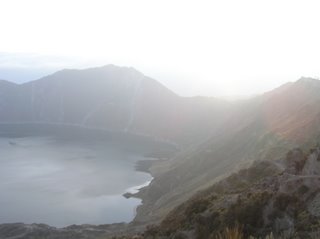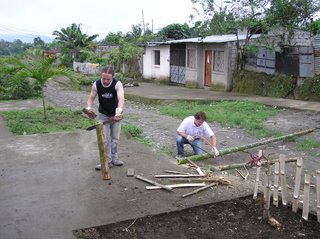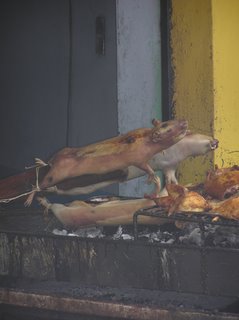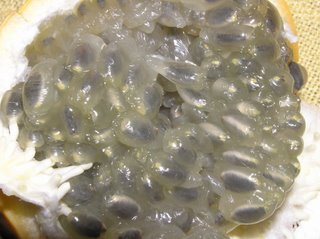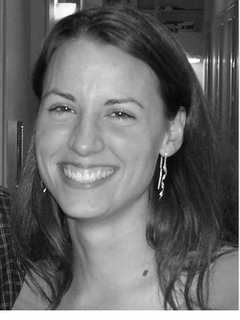This is the second part of a two part article that Carmen wrote documenting her experiences with the Habitat for Humanity Global Village program. Unfortunetly I had a bit of trouble adding some of her pics, so the article is not entirely complete! Carmen was my "roomie" my first week in Ecuador, and nursed me back to health when I was pretty ill for a couple days... and then I went to the doctor with her the next day!
Have Hammer, Will Travel…Part 2
Thoughts on the Road with Habitat for Humanity’s Global Village Program
By Carmen Español

*Carmen taking a break
Take 1 Family + 1 part Sweat + 2 parts Love = 1 Habitat Home (and Global Village Community). This is the basic “recipe” of my Habitat experience. It’s hard to put into words as I sit here writing a description of the project. It was truly an incredibly amazing experience that I’ll never forget, and I am sure that my whole team would agree with me. I learned that a house is more than bricks and mortar and a building. It’s a home that represents the community of individuals that create it. I left a big chunk of my heart in a home in Santo
Domingo, Ecuador.

(*Carmen and baby Aliso)
I worked alongside the “maestros” Raymundo and Jose and 16 other Habitat volunteers from the US, Ireland, Northern Ireland, England, New Zealand and Puerto Rico, as well as the local affiliate staff of Ecuador. In the short course of our stay, we became a small “family” as we physically worked together, ate, played, and interacted with one another.
(*Pic: James Plastering)
There were many construction lessons to learn on the project – how to mix cement, how to plaster, etc. But many life lessons as well. From the children I learned that language is not necessary or required for having fun or falling in love. No directions necessary for blowing bubbles. We all fell head over heels for the children and easily had fun without knowing a word of Spanish. It was easy with the innocence and sincerity that is a wonderful quality children have. Erica, Marianela, Anita, Natalie, Andrea, Diego, Santiago,  Leann, and baby Aliso’s smiles will be forever etched in my memory.
Leann, and baby Aliso’s smiles will be forever etched in my memory.
(*Pic: Erin getting water for the cement mix)
So too, will the hard work, companionship, and solidarity I witnessed from my team members – Jad, Lacy, Prissy, Betsy, Mike, Jimmy, Steve, Dave, Erin, Greg, Andrew, Marc, Francisco, Hugo, Ana Lucia, Valeria, and Narcisa be remembered. Many hands make the work light.
(*Pic: Dr. Marianela)
On Day One, I thought, I’m not gonna make it to the end of the week! I was exhausted and spent. Then we got to the hotel, showered, and were off to the welcome reception arranged by the local affiliate staff. The families and staff would all be there to meet us and get to know us. It was great to hear in our introductions, the various reasons people came and how their first day went. I was glad to hear that I wasn’t the only one who felt TIRED and then felt really proud of all our work when Hugo announced that our team had accomplished 3 days scheduled work in 1 day. We all went, WOW! Then the families shared their stories, and it felt like we were a team helping to make a dream come true. We worked together on something tangible and we could see the fruits of our labor and progress each day. The kids shining faces and hugs made all the soreness fade from memory and motivated us.

(*Pic: Greg, Prissy, Lacy & Dave taking a little siesta after lunch)
Each day we had activities planned after our work day ended and so our days were full of hard work and cultural activities. Day One we had the welcome reception and dinner with the families, Day Two a soccer match with the families (we won!) and dinner with them, Day Three a visit to the Tsachiles indigenous reservation, Day Four a visit to an orphanage for boys, and Day Five the dedication and blessing of the mostly-finished house and farewell reception. Our R&R day we had to head back to Quito, and stopped on the way back at Mindo Rainforest for hiking and rafting. Of course, we managed to squeeze in a little dancing and karaoke on a few of the days we weren’t totally exhausted.
The farewell reception with the families was joyous and wonderful, until the end. It was difficult emotionally and wrenching trying to say goodbye to everyone. We had formed attachments to the children. They were crying and clinging to us. After half an hour, the parents had to quite literally pull them off and drag them away. We were all upset, especially the guys.

I would encourage anyone reading this, to consider a volunteer vacation such as this. It is truly a rewarding and wonderful experience. Here are a few words from my team upon arrival home:
(Pic:v*Jose pulls Marianela from Ken to go home)
“I wish you all to settle back into normal life with fond memories of our team and our time in Ecuador. Never forget what we did there, and how we did it, with love.” ---Marc from Armagh, Northern Ireland
“You have certainly set the bar high for any teams I will work with in the future. Excellent team spirit, excellent hard work, excellent company and excellent memories. Please keep up your social contributions. As we saw our efforts truly change the lives of a family.” ---Jad from Washington DC
“Thank you all for making last week a very . . .very good week. Even with the rain forest experience (laughing) . . . If any of you meander your way to Chicago, please do give me a call . . . Mi casa es su casa . . .OR. . .as Jad would have said in Spanish . .. ‘My houso is your houso’, subsequently punctuated by "buEEENO!!!!!!" ---Ken from Chicago
For more information about Habitat International, go to:
http://www.habitat.org/gv/
For information on the Ecuador project, go to:
http://www.habitat.org/gv/mytrip/9201-6731
For Part 1 of this article go to page 4 of:
http://www.cpo.washington.edu/DOCMAN/WEB_FTP/DOCMANFTP/2006_Newsletter_September_20060906.pdf








